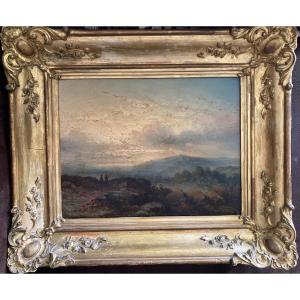(Paris 1795 - Paris 1875)
View taken in the canton of Bern - Switzerland
Oil on paper, mounted on canvas
H. 34.5 cm; W. 46 cm
Signed lower right
Circa 1835-1837
The son of a printer, Rémond became a pupil of Regnault very early on, in 1810, but it was Jean-Victor Bertin (his master at the Beaux-Arts in Paris in 1812), which directed him straight (between 1814 and 1816, Rémond however abandoned painting at the insistence of his parents, in favor of a commercial activity) towards the Grand Prix de Rome for historical landscape in 1821 with Proserpine and Pluton . This excellent draftsman then has a precise and polished touch that suits the rules of the genre. But as soon as he arrived in Rome, he discovered nature and outdoor painting; during this first stay in Italy, which lasted five years, he painted many small-format studies, with a touch that sometimes became wider and creamier, and a high quality of luminosity. His subjects are both the intramural sites of the Eternal City and the countryside and more mountainous areas; it also goes down to Naples and Paestum. Back in Paris, Rémond discovered his pedagogical desires, and at the same time as he opened a studio in 1827 (where he notably trained Théodore Rousseau), he published two theoretical treatises, "Principles of landscapes" and "Complete course of landscapes », just like Pierre-Henri de Valenciennes or Alphonse Mandevare had done before him.
In 1842, Rémond would return to Italy for several months, lingering particularly in Sicily. He will end his career with Norman or Ile-de-France landscapes, with a last participation in the Salon in 1848. A great traveler, Jean-Charles Rémond thoroughly explored Italy, Sicily, part of France, and he traveled in Switzerland for two years (1835 to 1837). The catalogs of the Salons mention in these years views taken in Neufchâtel or in the canton of Bern. In the latter, the artist has represented the city and Lake Thun, the heights of Grindelwald or Meiringen, or the banks of the Birse. The characteristic architecture of the Bern region, in particular its canted roofs, can be found in our painting, which can certainly be located in one of these places.








































 Le Magazine de PROANTIC
Le Magazine de PROANTIC TRÉSORS Magazine
TRÉSORS Magazine Rivista Artiquariato
Rivista Artiquariato